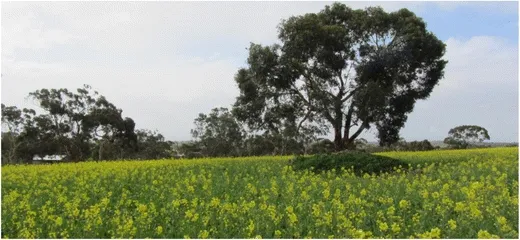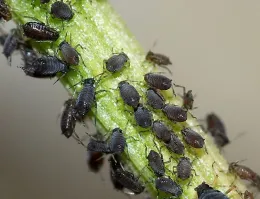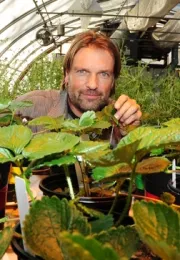Insects 'Living on the Edge': UC Davis Student Derrick Nguyen's Article in Prestigious Journal

Hoang Danh “Derrick” Nguyen, who is studying for his master's degree in entomology with major professor and agricultural entomologist Christian Nansen of the UC Davis Department of Entomology and Nematology, says that many species of insect pests, pollinators and natural enemies show distinct preferences for environmental edges, as they transition from one habitat to another.
“Characterization of insect pests' spatial distribution patterns can be used to guide and optimize precision pest management,” concluded Nguyen, the lead author, and Nansen, co-author and associate professor.
The paper, titled “Edge-Biased Distributions of Insects: A Review,” indicates that “the prevalence of such edge-biased distributions has considerable implications for how to sample and monitor insects, and it also suggests that in many cases pest management tactics, such as, releases of natural enemies or insecticide applications can be spatially targeted to field edges.”

Nguyen wrote the paper as an undergraduate student. “He decided to write a review article on a topic related to insect ecology and pest management,” Nansen said. “His main goals were to improve his scientific writing and to get familiar with the process of publishing scientific publications. The end result was an article about a very widespread—but poorly understood phenomenon—insects are often spatially aggregated along environmental edges.”
Nguyen traced the history of edge-based distribution of insects in agricultural systems to a study on black bean aphids led by British entomologist C. G. Johnson and published in 1950 in the Annual of Applied Biology. The aphids, major pests of sugar beet, bean and celery crops, spread from the field edges to within, but the edges remained the areas of highest aphid density.
Nguyen also called attention to scientific studies that found that wild bees in high bush blueberry were more prevalent along the edges of orchards, and that the density of the pest, Asian citrus psyllid, prevailed more at the edges of citrus groves than within.
Nansen praised Nguyen's work as outstanding. “Sometimes we professors are fortunate enough to interact with undergraduate students who – even with English not being their first language – possess keen abilities to describe a scientific problem or phenomenon in clearly articulated scientific writing, and Derrick is a great example of that!”

“ We are supposed to focus more and more on ‘diversity' and here we have an undergraduate from Singapore publishing in a very prestigious journal,” he added.
In their paper, the UC Davis scientists suggested that mathematical modeling approaches can partially explain edge-biased distributions but “that abiotic factors, crop vegetation traits, and environmental parameters are factors that are likely responsible for this phenomenon.”
They advocate more research, especially experimental research, “to increase the current understanding of how and why edge-biased distributions of insects are so widespread.”
“In my opinion, discussions about edge-biased distribution of insects tend to be entomocentric; much emphasis is often put on the insects themselves,” Nguyen commented. “However, agricultural insect pests are dependent on their host plants for survival. Interestingly, it has been shown in various systems that agricultural crops also display edge effect as well. Therefore, through my review, I would like to bring attention to this correlation and propose insect-plant interactions as a potential explanation of edge effect and broaden the discussion about this widely observed but insufficiently understood phenomenon.”
Nguyen received a bachelor's degree in plant sciences from UC Davis in December 2017, graduating with highest honors. A high-achieving scholar, he was on the dean's honor list, College of Agricultural and Environmental Sciences, every quarter since the fall of 2015. He enrolled in the UC Davis graduate student program in entomology in January 2018.
“I am interested in IPM, insect behavior and insect ecology, and greenhouse production of leafy vegetables,” he said. “Currently I am working on projects that explore the potentials of hyperspectral imaging technology as early detection tools for pest infestation and insect host selection based on the framework of preference-performance hypothesis. As my research model, I focus on the interactions between vegetables (bok choy and spinach) and their insect pests (leafminers and armyworms).
His projects include researching:
- Hyperspectral imaging of bok choy and spinach in response to leafminer and armyworm infestation
- Diurnal variation in reflectance signature of plants
- Host selection behavior of leafminers and armyworms based on the understanding of "Preference-Performance Hypothesis"
- Behavioral avoidance of armyworms in spinach and its implication in Integrated Pest Management
Nguyen served as an assistant training officer with the Singapore Armed Forces (SAF) from April 2014 to March 2015. For his studies at UC Davis, received a 2015-2019 undergraduate and graduate scholarship sponsored by Agri-Food and Veterinary Authority of Singapore.
“For my career plan, since I am currently sponsored by AVA, I will be working for them for six years upon my graduation,” Nguyen said. “In the long term, I am interested in doing a Ph.D in imaging technology for pest detection, plant health status analysis and food quality analysis.”
